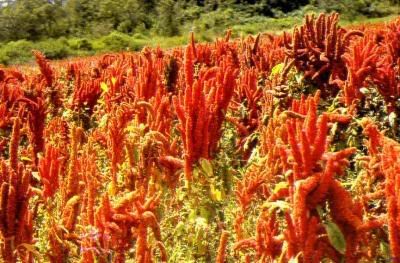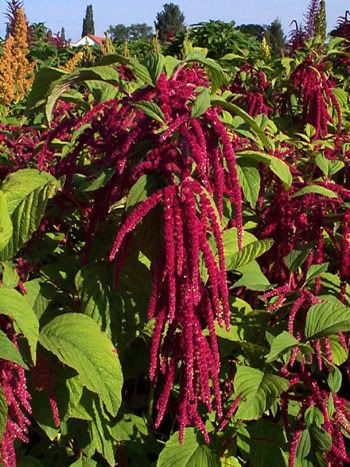Republished from DailyKos Mon Mar 10, 2008 at 01:00 PM PDT
Amaranth can feed the world..

Amaranth grain
Amaranth has a long and interesting history in Mexico where it's been grown and harvested for thousands of years by the Mayan and Incan civilizations. The Aztecs believed Amaranth had magical properties that would give them amazing strength.Because it was important culturally to the Aztecs, the conquistadors did their best to eradicate it. Fortunately for us, they were not entirely successful. I say fortunately because it may be the grain that saves us from mass starvation on a global scale.
More below the fold..

Mixed with corn flour or meal, amaranth flour or meal, is a complete food for humans. It has all the proteins and amino acids the human body requires for maintenance.
Amaranth is also a dual crop, the grain is a foodstuff for people, the stalks and leaves combined with corn stalks and leaves, are a complete feed for livestock. It can be fed in round bales or as silage.
Amaranth puts nitrogen back into the soil naturally, eliminating the need for artificial nitrates which run off and pollute the water ways. A field can be kept in good shape by rotating amaranth with corn without adding any artificial fertilizer.
Amaranth’s great nutritional qualities are the driving force powering it’s comeback. It’s high in protein, particularly in the amino acid, Lysine, which is low in the cereal grains. In fact, Amaranth has the highest lysine content of all the grains in this study with Quinoa coming in a close second. To make your whole wheat bread a complete protein, substitute about 25% of your wheat flour with Amaranth flour. Amaranth, by itself, has a really nice amino acid blend. Just 150 grams of the grain is all that’s required to supply an adult with 100% of the daily requirement of protein. Amaranth is one of the highest grains in fiber content. This makes Amaranth an effective agent against cancer and heart disease. Amaranth is also the only grain in this study that contains significant amounts of phytosterols which scientists are just now learning play a major part in the prevention of all kinds of diseases. Amaranth is also rich in many vitamins and minerals.Here is the table comparing amaranth with wheat. Stunning to say the least.
Amaranth must be cooked before it is eaten because it contains components in it’s raw form that block the absorption of some nutrients in our digestive system. You should cook Amaranth whether you plan on giving it to your family or your pets.
Nutrients in 100 Grams of Amaranth(Sorry about the wiggly table, I tried to correct, but wasn't able to make it work right.)
Unit Amount % More
of In Than
Nutrient Measure Amaranth Wheat
Food energy KCal: 374.000 114
Protein Gms: 14.450 115
Total lipid (fat) Gms: 6.510 423
Total saturated fat Gms: 1.662 618
Ttl monounsaturated fat Gms: 1.433 717
Ttl polyunsaturated fat Gms: 2.891 461
Total dietary fiber Gms: 15.200 121
Ascorbic acid Mg : 4.200 Infinite
Riboflavin Mg : 0.208 181
Folacin Mcg: 49.000 129
Potassium Mg : 366.000 101
Calcium Mg : 153.000 528
Phosphorus Mg : 455.000 158
Magnesium Mg : 266.000 211
Iron Mg : 7.590 238
Zinc Mg : 3.180 120
Copper Mg : 0.777 179
Palmitic acid (16:0) Gms: 1.284 549
Oleic acid (18:1) Gms: 1.433 746
Linoleic acid (18:2/n6) Gms: 2.834 472
Phytosterols Mg : 24.000 Infinite
Histidine Gms: 0.389 136
Isoleucine Gms: 0.582 127
Leucine Gms: 0.879 103
Lysine Gms: 0.747 223
Methionine Gms: 0.226 112
Threonine Gms: 0.558 153
Tryptophan Gms: 0.181 113
Valine Gms: 0.679 122
Arginine Gms: 1.060 178
Alanine Gms: 0.799 176
Amaranth can be grown successfully in just about every place on the planet, from Nepal to South America, from India to East Africa. It grows in poor soils, and improves them while growing.
Here are some links to pages that will give you more information, and recipes, on amaranth.
Puente a la Salud Comunitaria
Special Foods
No comments:
Post a Comment